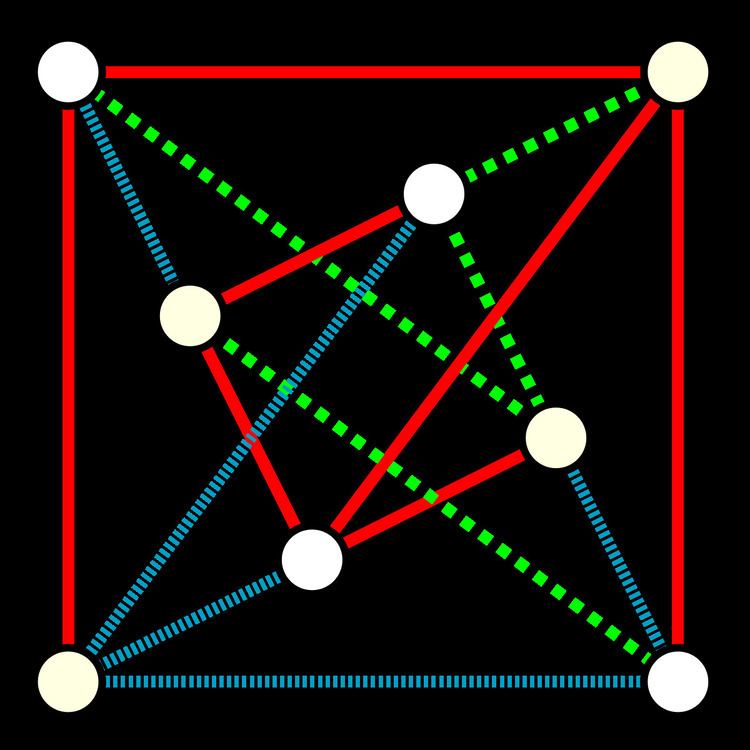 | ||
The arboricity of an undirected graph is the minimum number of forests into which its edges can be partitioned. Equivalently it is the minimum number of spanning forests needed to cover all the edges of the graph.
Contents
Example
The figure shows the complete bipartite graph K4,4, with the colors indicating a partition of its edges into three forests. K4,4 cannot be partitioned into fewer forests, because any forest on its eight vertices has at most seven edges, while the overall graph has sixteen edges, more than double the number of edges in a single forest. Therefore, the arboricity of K4,4 is three.
Arboricity as a measure of density
The arboricity of a graph is a measure of how dense the graph is: graphs with many edges have high arboricity, and graphs with high arboricity must have a dense subgraph.
In more detail, as any n-vertex forest has at most n-1 edges, the arboricity of a graph with n vertices and m edges is at least
Any planar graph with
Algorithms
The arboricity of a graph can be expressed as a special case of a more general matroid partitioning problem, in which one wishes to express a set of elements of a matroid as a union of a small number of independent sets. As a consequence, the arboricity can be calculated by a polynomial-time algorithm (Gabow & Westermann 1992).
Related concepts
The star arboricity of a graph is the size of the minimum forest, each tree of which is a star (tree with at most one non-leaf node), into which the edges of the graph can be partitioned. If a tree is not a star itself, its star arboricity is two, as can be seen by partitioning the edges into two subsets at odd and even distances from the tree root respectively. Therefore, the star arboricity of any graph is at least equal to the arboricity, and at most equal to twice the arboricity.
The linear arboricity of a graph is the minimum number of linear forests (a collection of paths) into which the edges of the graph can be partitioned. The linear arboricity of a graph is closely related to its maximum degree and its slope number.
The pseudoarboricity of a graph is the minimum number of pseudoforests into which its edges can be partitioned. Equivalently, it is the maximum ratio of edges to vertices in any subgraph of the graph, rounded up to an integer. As with the arboricity, the pseudoarboricity has a matroid structure allowing it to be computed efficiently (Gabow & Westermann 1992).
The thickness of a graph is the minimum number of planar subgraphs into which its edges can be partitioned. As any planar graph has arboricity three, the thickness of any graph is at least equal to a third of the arboricity, and at most equal to the arboricity.
The degeneracy of a graph is the maximum, over all induced subgraphs of the graph, of the minimum degree of a vertex in the subgraph. The degeneracy of a graph with arboricity
The strength of a graph is a fractional value whose integer part gives the maximum number of disjoint spanning trees that can be drawn in a graph. It is the packing problem that is dual to the covering problem raised by the arboricity. The two parameters have been studied together by Tutte and Nash-Williams.
The fractional arboricity is a refinement of the arboricity, as it is defined for a graph
The (a,b)-decomposability generalizes the arboricity. A graph is
